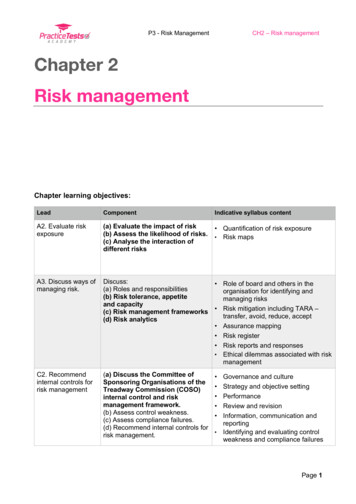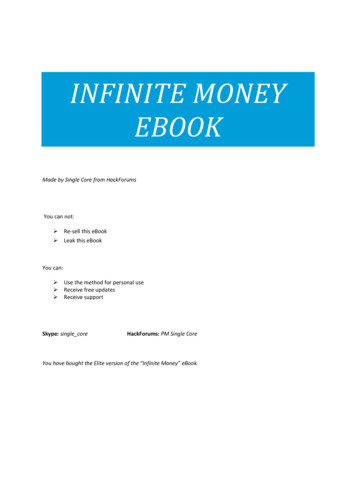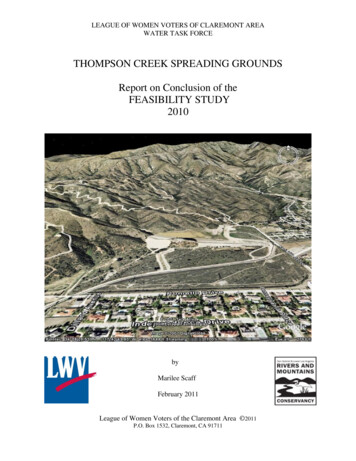
Transcription
THE BASICS OF INVESTING:DIVERSIFY YOUR PORTFOLIOSpreading your risk acrossdifferent asset classes1
THE BASICS OF INVESTING:WHAT IS DIVERSIFICATION? Spreads risk among differentasset classes May reduce overallportfolio volatility* Asset class performance varies Diversify Across Asset Classes Within Asset ClassesNon-EquitiesEquities* Diversification is a technique to help reduce risk. There is no absolute guarantee that diversification will protect against a loss of income. Pleasekeep in mind that there are risks associated with investing in securities including loss of principal.2
How time helps manage riskThe range of annual total returns for common stocks* (1926-2012)Average ranges of %-1.38%-20%-12.47%-40%-60%-43.34%1 YearHighest Annual Return5 YearsLowest Annual Return10 YearsAverage ReturnChart illustrates returns from 1/1/1926 – 12/31/2012. Source: Ibbotson Associates, a wholly owned subsidiary ofMorningstar, Inc. These returns are illustrative only and do not reflect TIAA-CREF performance; past performance isn’tindicative of future results. Benchmark: Ibbotson Associates, Inc., S&P 500 Index. You cannot invest directly into an index.
How time helps manage riskThe range of annual total returns for corporate bonds (1926-2012)Average ranges of return60%42.56%40%22.51%20%0%-20%6.06%-8.09%1 YearHighest Annual Return6.05%16.32%6.00%0.98%-2.22%5 YearsLowest Annual Return10 YearsAverage ReturnChart illustrates returns from 1/1/1926 – 12/31/2012. Source: Ibbotson Associates, a wholly owned subsidiary ofMorningstar, Inc. These returns are illustrative only and do not reflect TIAA-CREF performance; past performance isn’tindicative of future results. Benchmark: Ibbotson U.S. Long-Term Corporate Bonds. You cannot invest directly into an index.
THE BASICS OF INVESTING:UNDERSTANDING ASSET CLASSES A group of investments that share commoncharacteristics Risk may decrease as the number of assetclasses increases Help manage risk by diversifying holdings amongdifferent asset classes5
Market timing can be dangerousHypothetical value of 1 invested from 1980-2012 35.00 33.21 30.00 25.00 20.00 15.00 7.63 10.00 4.98 5.00 0.00S&P 500S&P 500 minus best 15monthsTreasury BillsChart illustrates returns from 1/1/1980 to 12/31/2012. 2012 Ibbotson Associates, Inc., a wholly owned subsidiary ofMorningstar, Inc. Source: Large Company Stocks – Standard & Poor’s 500 , which is an unmanaged group of securities andconsidered to be representative of the stock market in general. An investment cannot be made directly in an index. Stocks arenot guaranteed and are more volatile than other asset classes. Chart is for illustrative purposes only and not indicative of anyTIAA-CREF investment. Past performance is not a guarantee of future results.
THE BASICS OF INVESTING:WHAT’S THE BEST ASSETALLOCATION MIX FOR YOU?Based on your risk tolerance,what category of investor are you?7
THE BASICS OF INVESTING:ASSET ALLOCATION IS IMPORTANT7%Conservative13%Guaranteed*Fixed IncomeEquitiesReal EstateMoneyMarket27%40%13%*Based on the claims-paying ability of TIAA.The specific asset allocations shown in the model portfolios were generated by IbbotsonAssociates, one of the nation’s leading financial advisors. They are based on well-knownoptimization techniques, using historical return, volatility and correlation data from indices like theRussell 1000 stock index. This optimization procedure is based on assumptionsabout historical market data, and future market conditions may vary from these assumptions.
THE BASICS OF INVESTING:ASSET ALLOCATION IS IMPORTANT7%ModerateGuaranteed*Fixed Income20%EquitiesReal EstateMoneyMarket53%5%15%*Based on the claims-paying ability of TIAA.The specific asset allocations shown in the model portfolios were generated by Ibbotson Associates,one of the nation’s leading financial advisors. They are based on well-known optimizationtechniques, using historical return, volatility and correlation data from indiceslike the Russell 1000 stock index. This optimization procedure is based on assumptionsabout historical market data, and future market conditions may vary from these assumptions.
THE BASICS OF RETIREMENT:ASSET ALLOCATION IS IMPORTANT10%5%AggressiveGuaranteed*Fixed IncomeEquitiesReal Estate85%MoneyMarket*Based on the claims-paying ability of TIAA.The specific asset allocations shown in the model portfolios were generated by IbbotsonAssociates, one of the nation’s leading financial advisors. They are based on well-knownoptimization techniques, using historical return, volatility and correlation data from indices like theRussell 1000 stock index. This optimization procedure is based on assumptionsabout historical market data, and future market conditions may vary from these assumptions.
THE BASICS OF INVESTING:PORTFOLIO ADJUSTMENTS ARENOT TIMING OF THE MARKETRebalancing and Reallocationare asset allocation strategiesused to methodically restoreyour portfolio targetsRebalancing does not protect against loss or guarantee that your financial goals will be met.11
THE BASICS OF INVESTING:WHAT IS REALLOCATION?Making new contributions to accounts that are different from those youoriginally selected.ORIGINAL ALLOCATION*NEW ALLOCATION*New AccountPremiums20% Fixed80% Equity35% Fixed65% Equity12
THE BASICS OF INVESTING:WHAT IS REBALANCING?Adjusting the current assets in your portfolio to restore your original targetORIGINAL ALLOCATION*NEW ALLOCATION*New AccountPremiums35% Fixed65% Equity20% Fixed80% EquityRebalanceYour Accounts*13
THE BASICS OF INVESTING:ASSET ALLOCATION SUMMARY Avoid market timing Include several different asset classes Rebalance your portfolio Reallocate your contributions when needed14
Questions and AnswersFor Institutional Investor Use Only. Not for Use with or Distribution to the Public. 15
Important InformationInvestment, insurance and annuity products are not FDIC insured, are not bank guaranteed, are not bankdeposits, are not insured by any federal government agency, are not a condition to any banking service oractivity and may lose value.Investment products may be subject to market and other risk factors. See the applicable product literatureor visit www.tiaa-cref.org/ndpers for details.You should consider the investment objectives, risks, charges andexpenses carefully before investing. Please call 877 518-9161 or visitwww.tiaa-cref.org/ndpers for a current prospectus that contains this and otherinformation. Please read the prospectus carefully before investing.TIAA-CREF Individual & Institutional Services, LLC and Teachers Personal Investors Services, Inc., members FINRA, distribute securities products. Annuitycontracts and certificates are issued by Teachers Insurance and Annuity Association (TIAA) and College Retirement Equities Fund (CREF), New York, NY.Brokerage Services are provided by TIAA-CREF Brokerage Services, a division of TIAA-CREF Individual & Institutional Services, LLC. Member FINRA/SIPC. 2011 Teachers Insurance and Annuity Association–College Retirement Equities Fund (TIAA-CREF), 730 Third Avenue, New York, NY 10017.C1302 16
THE BASICS OF INVESTING: DIVERSIFY YOUR PORTFOLIO . Spreading your risk across different asset classes . 1 . THE BASICS OF INVESTING: 2 . WHAT IS DIVERSIFICATION? * Diversification is a technique to help reduce risk. There is no absolute guarantee that diversification will protect agains t a loss of income. . Real Estate Money Market . ASSET .










